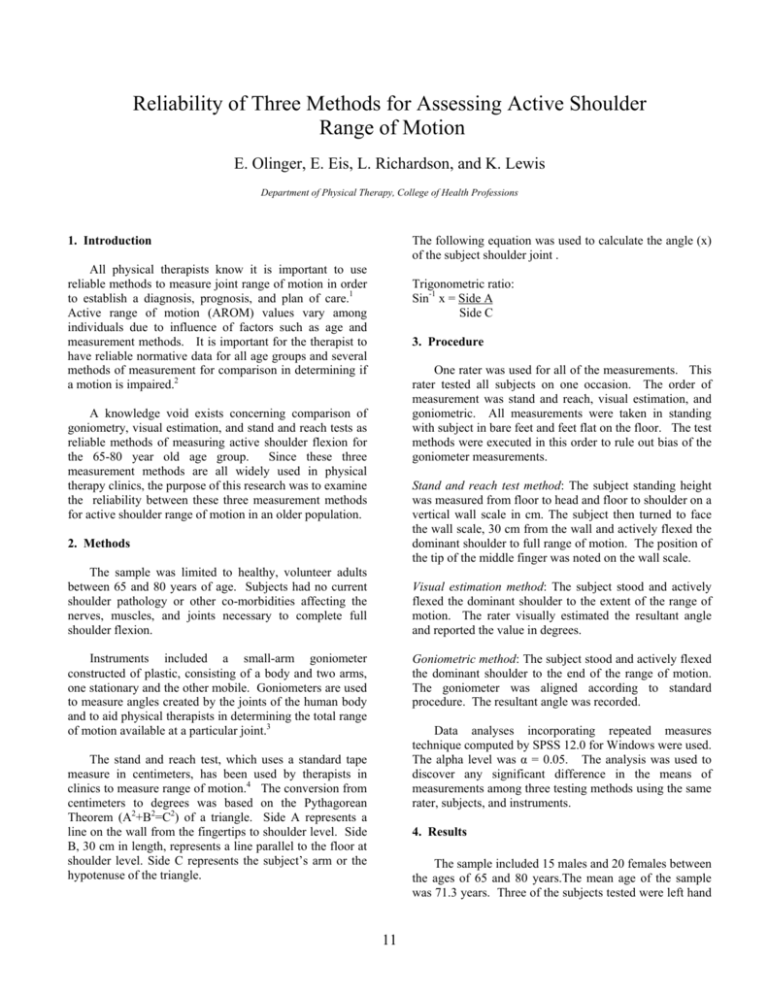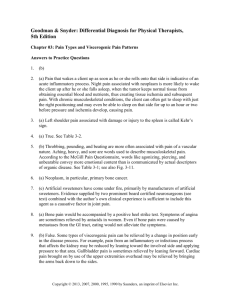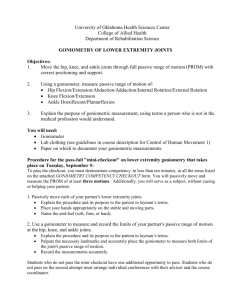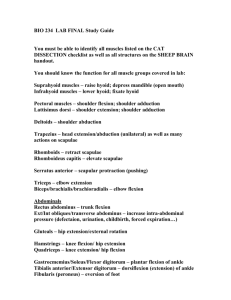Reliability of three methods for assessing active shoulder range of
advertisement

Reliability of Three Methods for Assessing Active Shoulder Range of Motion E. Olinger, E. Eis, L. Richardson, and K. Lewis Department of Physical Therapy, College of Health Professions The following equation was used to calculate the angle (x) of the subject shoulder joint . 1. Introduction All physical therapists know it is important to use reliable methods to measure joint range of motion in order to establish a diagnosis, prognosis, and plan of care.1 Active range of motion (AROM) values vary among individuals due to influence of factors such as age and measurement methods. It is important for the therapist to have reliable normative data for all age groups and several methods of measurement for comparison in determining if a motion is impaired.2 Trigonometric ratio: Sin-1 x = Side A Side C 3. Procedure One rater was used for all of the measurements. This rater tested all subjects on one occasion. The order of measurement was stand and reach, visual estimation, and goniometric. All measurements were taken in standing with subject in bare feet and feet flat on the floor. The test methods were executed in this order to rule out bias of the goniometer measurements. A knowledge void exists concerning comparison of goniometry, visual estimation, and stand and reach tests as reliable methods of measuring active shoulder flexion for the 65-80 year old age group. Since these three measurement methods are all widely used in physical therapy clinics, the purpose of this research was to examine the reliability between these three measurement methods for active shoulder range of motion in an older population. Stand and reach test method: The subject standing height was measured from floor to head and floor to shoulder on a vertical wall scale in cm. The subject then turned to face the wall scale, 30 cm from the wall and actively flexed the dominant shoulder to full range of motion. The position of the tip of the middle finger was noted on the wall scale. 2. Methods The sample was limited to healthy, volunteer adults between 65 and 80 years of age. Subjects had no current shoulder pathology or other co-morbidities affecting the nerves, muscles, and joints necessary to complete full shoulder flexion. Visual estimation method: The subject stood and actively flexed the dominant shoulder to the extent of the range of motion. The rater visually estimated the resultant angle and reported the value in degrees. Instruments included a small-arm goniometer constructed of plastic, consisting of a body and two arms, one stationary and the other mobile. Goniometers are used to measure angles created by the joints of the human body and to aid physical therapists in determining the total range of motion available at a particular joint.3 Goniometric method: The subject stood and actively flexed the dominant shoulder to the end of the range of motion. The goniometer was aligned according to standard procedure. The resultant angle was recorded. Data analyses incorporating repeated measures technique computed by SPSS 12.0 for Windows were used. The alpha level was α = 0.05. The analysis was used to discover any significant difference in the means of measurements among three testing methods using the same rater, subjects, and instruments. The stand and reach test, which uses a standard tape measure in centimeters, has been used by therapists in clinics to measure range of motion.4 The conversion from centimeters to degrees was based on the Pythagorean Theorem (A2+B2=C2) of a triangle. Side A represents a line on the wall from the fingertips to shoulder level. Side B, 30 cm in length, represents a line parallel to the floor at shoulder level. Side C represents the subject’s arm or the hypotenuse of the triangle. 4. Results The sample included 15 males and 20 females between the ages of 65 and 80 years.The mean age of the sample was 71.3 years. Three of the subjects tested were left hand 11 measurements were used to collect data. Another aspect for further study could include a greater number of subjects, or a study to compare the measurements taken from the dominant arm to that of the non-dominant arm. This study was limited to active older adults, therefore research using a more diverse sample or specifically sedentary older adults, middle-aged adults, adolescents, or obese adults could bear different results. dominant and 32 of the subjects were right hand dominant. Intra-rater intraclass correlation coefficients (ICC), means and standard deviations for each movement are found in Table 1. 5. Discussion For the comparison of goniometric vs. visual estimation, the ICC was excellent. Comparison of stand and reach with goniometric and visual estimation resulted in ICCs that were very poor. These comparisons agree with the means for each method of measurement. 6. Conclusion Excellent agreement can be expected when a therapist interchanges visual estimation and goniometric measurements of active shoulder flexion from session to session to assess a patient’s progress. If the stand and reach method is commonly used in the clinic, agreement with other common measurement tools (visual estimation or goniometry) will be questionable. Limitations to the study were found in the stand and reach method. It was difficult to judge how much of the subject’s weight was distributed to the wall during the stand and reach measurements. Subjects could have used the wall to climb higher on the scale, although otherwise instructed. It could be possible that stand and reach is more accurately a measure of passive range of motion. Other limiting factors included the sample size, as well as the time of day measurements were taken. The presence of kyphosis or osteoporosis affecting shoulder AROM could have affected measurements. 7. Acknowledgements Barbara Smith, PhD, PT, assisted in the statistical analysis for this study. 8. References Further study should be conducted to fully investigate all aspects of this topic. Some texts suggest that a longarm goniometer should be used for large body segments, while a short-arm goniometer should be used for small Other studies, however, report no body segments.3 difference in reliability between large and small-arm goniometers.5 This study included only a small-arm goniometer, therefore, a successive study could compare the reliability between the two sizes of goniometers. Different results would be expected if inter-tester [1.] Guide to Physical Therapist Practice, 2nd ed. APTA; 2003: chap 2. [2.] O’Sullivan, SB. Physical Rehabilitation: Assessment and Treatment. 4th ed. Philadelphia, Pa: Davis; 2001:chap 5. [3.] Norkin, CC, White DJ. Measurement of Joint Motion, A Guide to Goniometry. 3rd ed. Philadelphia, Pa: Davis; 2003: chap [4.] Hayes K, Walton J R, Szomor Z L, Murrell G A C. Reliability of five methods for assessing shoulder range of motion. Aust J Physiother. 2001; 47:289-294. [5] Riddle DL, et al. Goniometric Reliability in a Clinical Setting. Shoulder Measurements. Phys Ther. 1987: 67(5): 667-73. Table 1: Results of Statistical Analysis: Shoulder Flexion in degrees by Method of Measurement Method of Mean (°) +/- Difference in Significance ICC* Measurement SD the Mean (°) Level Stand and Reach 156.6 +/-1.5 5.1 .002 .12 Visual estimation 151.4 +/-9.5 Stand and Reach 156.6 +/-1.5 5.9 .001 .06 Goniometry 150.7 +/-9.2 Visual estimation 151.4 +/-9.5 0.7 .445 .83 Goniometry 150.7 +/-9.2 *Intraclass Correlation Coefficient 12







